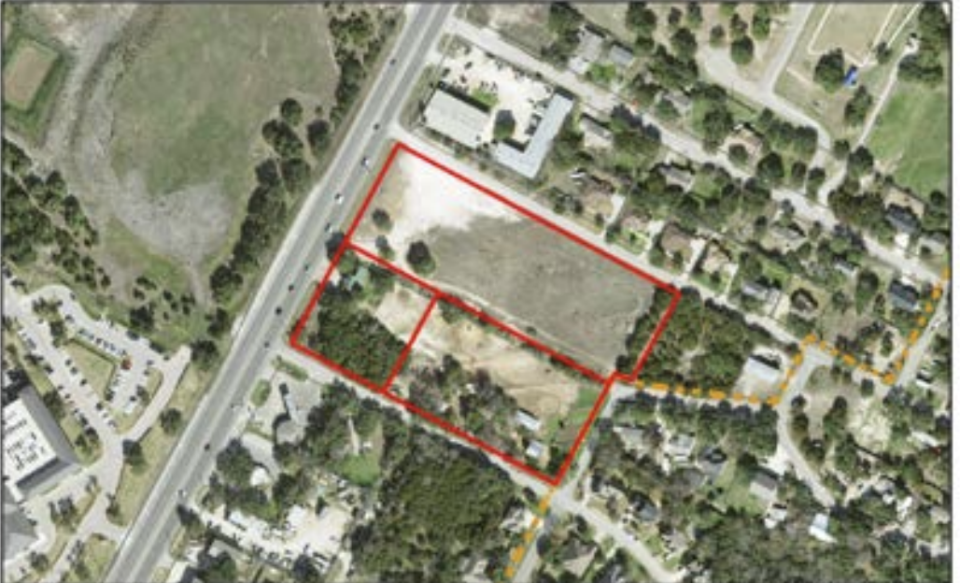'A gated city for millionaires is not sustainable' — Lakeway shoots down workforce housing plan
The Lakeway City Council voted Monday night to reject a proposal for a workforce housing planned unit development on Nightingale Lane. Council members spoke in favor of finding a place for workforce housing in the city but rejected this proposal in a 4-3 vote based in part on concerns about the location.
The land proposed for the development is along the RM 620 corridor and zoned for commercial and agricultural use. Mayor Tom Kilgore said he had misgivings about giving up a commercial lot that might make a good spot for future business development that would increase the city’s sales tax revenue.
The proposal on the table at the meeting included 248 units on 3.8 acres of land with three-story apartment buildings and a parking garage in the middle of the property and a 1-acre park. That works out to 32 units per acre, which is significantly higher than the city’s densest permitted 12-units-per-acre zoning.

The project was intended to serve the city’s workforce, including teachers, firefighters and service workers. Across the apartments, the average household income would have been required to be at 60% of the area median, according to developers Kent and Meg Conine of Conine Residential Group. That would help workers and families who make between about $40,000 and $60,000 a year to have an option to live in Lakeway, Meg Conine said.
Kent Conine said at the meeting that given the price of land, this density is required for a project to offer below-market rates on rent. However, members of the council were not willing to consider that level of density and would only vote on the proposal with the condition that the density be reduced to 20 units per acre, which is closer to the county-wide average for workforce housing developments and which brings the proposed buildings down to two stories.
Even with the condition of lower density included as part of the vote, the proposal was rejected. Council members Gretchen Vance, Sanjeev Kumar and Laurie Higginbotham voted in favor, while Kilgore, Mayor Pro Tem Louis Mastrangelo and council members Keith Trecker and Steve Smith voted against.
More: Special Olympics Texas bringing state games to Lake Travis area in February
The Conines pitched this project as an important policy decision for the city and suggested this plot of land is one of the only remaining places left in Lakeway that would work for workforce housing. Several members of the City Council said they did not agree with that assessment and that creative solutions exist to make other plots of land work.
Beyond the location, another concern raised by the council was the small size of the lot would have prevented much of a buffer area between the three-story apartments and adjacent single-family homes.
Kilgore said the city received over 100 communications from residents about the project, with people speaking both for and against it. Many of those opposed raised concerns about increased traffic and pedestrian safety with additional cars in the area, as well as with the high density of the project.
Those in favor of the project, including local business owners and members of the Lake Travis Chamber of Commerce, spoke at the meeting about the need for workforce housing in Lakeway to help businesses retain staff.
Michele Smallwood, who owns Tutor Doctor Lakeway, said she has offered to pay for her employees’ gas and offers high pay and good benefits and still struggles to keep employees, which is negatively affecting her ability to serve local students.
Christy Black, the owner of Primrose School of Lakeway, has 25 employees in Lakeway but only one of them lives in the city. The rest commute long distances, including one who drives from San Antonio and another from San Marcos, she said.
“Your Lakeway businesses are suffering and I would hope that y’all would want to support your businesses,” Black said.
More: Bee Cave City Council takes steps on affordable housing amid labor shortage
Council members agreed that workforce housing is needed in Lakeway, despite the rejection of this project. Lakeway is not the only city grappling with this issue. Neighboring Bee Cave also has been facing pressure from local businesses to increase the stock of workforce housing and recently took the first step toward the construction of workforce housing on the city-owned Skaags property.
Higginbotham said she would like to see the city take more action on this issue to help young families, teachers, artists, first responders and other people who make less money live in the area.
“We need to address these issues and not just say loftily we’re in favor of solving these problems and never do anything about them,” she said. “A gated city for millionaires is not sustainable without a diversity of housing. ... We need to get the concept of workforce housing in place sooner rather than later.”
Mastrangelo agreed the city needs to do more to address workforce housing needs but said the city already has taken some steps, including requiring 5% workforce housing be included in the Square at Lohmans development. Mastrangelo was among several members of the council who offered to serve on a subcommittee to study the issue further.
This article originally appeared on Austin American-Statesman: Lakeway city council votes down affordable housing proposal

